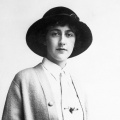 Dame Agatha Mary Clarissa Christie, Lady Mallowan, (15 September 1890 – 12 January 1976) was an English writer known for her sixty-six detective novels and fourteen short story collections, particularly those revolving around fictional detectives Hercule Poirot and Miss Marple. She also wrote the world's longest-running play, The Mousetrap, which was performed in the West End from 1952 to 2020, as well as six novels under the pseudonym Mary Westmacott. In 1971, she was appointed a Dame Commander of the Order of the British Empire (DBE) for her contributions to literature. Guinness World Records lists Christie as the best-selling fiction writer of all time, her novels having sold more than two billion copies.
Dame Agatha Mary Clarissa Christie, Lady Mallowan, (15 September 1890 – 12 January 1976) was an English writer known for her sixty-six detective novels and fourteen short story collections, particularly those revolving around fictional detectives Hercule Poirot and Miss Marple. She also wrote the world's longest-running play, The Mousetrap, which was performed in the West End from 1952 to 2020, as well as six novels under the pseudonym Mary Westmacott. In 1971, she was appointed a Dame Commander of the Order of the British Empire (DBE) for her contributions to literature. Guinness World Records lists Christie as the best-selling fiction writer of all time, her novels having sold more than two billion copies.
As a child, Agatha received a good home education, which was mainly given to her by her American father. Her mother, Clara, was an excellent storyteller and did not want to teach her beloved younger daughter to read until she was eight years old. But the girl, out of boredom, independently learned to read at the age of five, having absorbed the works of the English children's writer Edith Nesbit "The Story of the Treasure Seekers" and "The Railway Children", as well as the novel "Little Women" by American writer Louise May Alcott. Also, she made up imaginary friends for herself, played with her animals, attended dance classes, and began writing poetry.
There is an assumption that the reason for Christie's appeal to the detective was a dispute with her older sister Madge (who has already shown herself to be a writer), that she, too, can create something worthy of publication. Only in the seventh publishing house, the manuscript was printed in 2000 copies. The aspiring writer received a 25-pound fee.
"Ten Little Niggers" is a detective novel by Agatha Christie, written in 1939. In English-speaking countries, the novel is published under the title "And Then There Were None". This is the best-selling book by the writer, and, by her admission, the most difficult to create. The novel has been adapted about 10 times. Included in the"100 best detective novels of all time".
A situation that makes fans of good detective stories immediately begin to beat faster: an empty island, cut off from the rest of the world; a large mysterious house with many rooms and dark corridors; and ten completely unfamiliar, dissimilar people who come to the house at the invitation of the owner of the Negro Island. Here they will find a cozy atmosphere, delicious food, comfortable bedrooms. But the illusion of enviable hospitality does not last long. Soon the guests will realize that they are trapped by the sick imagination of a homicidal maniac. The trap snapped shut the moment they set foot on the rocky ground of the island. It is impossible to escape from the island, people are plunged into the abyss of suspicion, fear, and horror of imminent death — and only a sinister children's counting book and porcelain figures in the form of small Negroes calmly count down to the final of this terrible game…
The novel was published in 1939. I can't believe that it was written so long ago — it seems that it could have been written by a modern author. The archaic tone of the style is almost imperceptible, and even if it is, it is easily lost in the fascination of reading. The conceptual elements of the book — the isolated scene, the sophisticated methods of murder, the "He's among us!" fears-were nothing new at the time of writing. The elements of the Thriller that were honed to perfection became revolutionary: a creepy nursery rhyme that turned into a death list, mysteriously disappearing figures, and most importantly, amazingly deep and reliably worked out psychological portraits of the characters. All this, combined with a specific style, created a spirit of mysticism and Apocalypse that reigned over the Negro island.
In General, "Ten Little Niggers" evades in the direction of mysticism and even horror as far as it is possible in the framework of a classic detective story. This is not an investigation of Hercule Poirot or Sherlock Holmes, where the figures of brilliant detectives calm the reader, no matter what the hell is going on around: we know that in the end everything will be calculated, solved, and chewed up to us, incomprehensible, the best way. "Ten Little Niggers", on the contrary, consists entirely of innuendos and half-shadows. Even when the last page is turned and all the secrets of the island are revealed, there is a feeling that not everything that happened to the characters can be explained by reasons from this world.
By the way, abroad, for the sake of political correctness, all-new editions of the novel are published under the title "... And Then There Were None", and all references to Niggers in the text are replaced with little Indians, even the island was called Indian.
Zhamilya Mashabayeva, Librarian of the International Book Department

